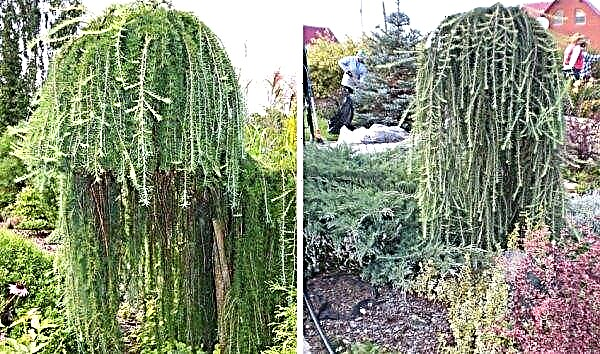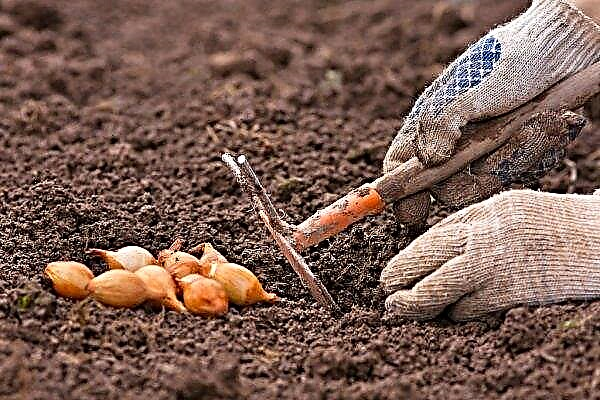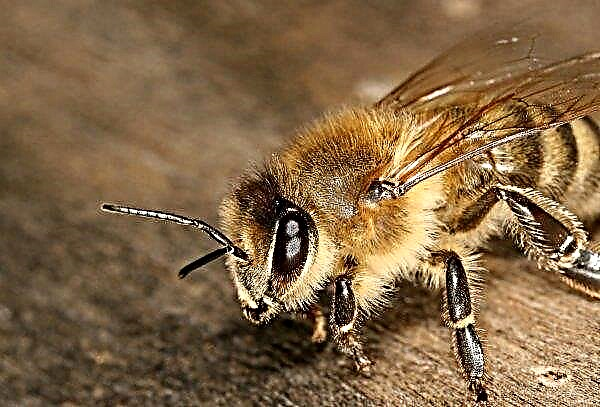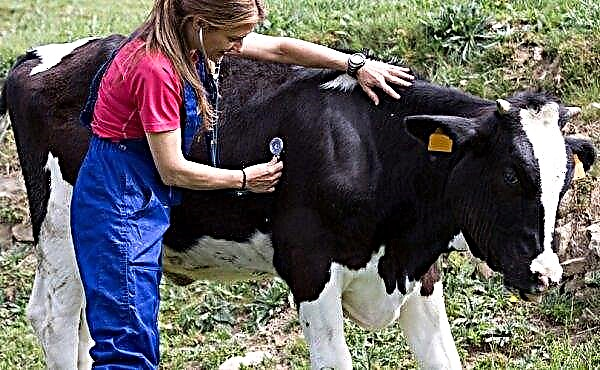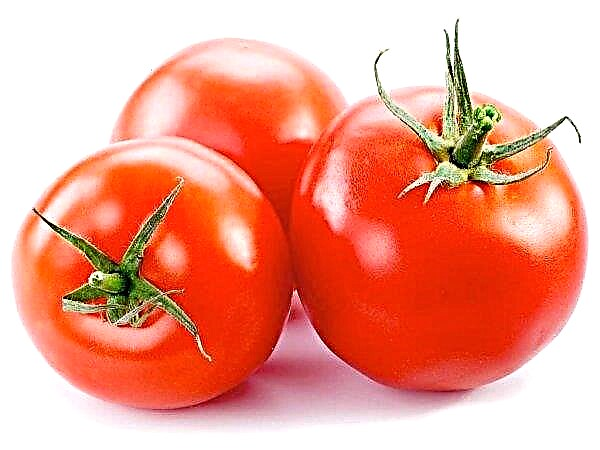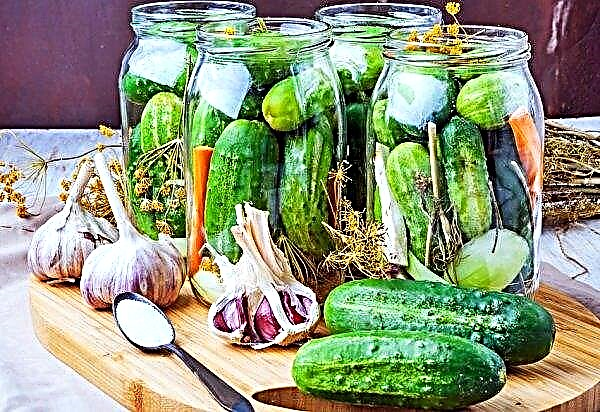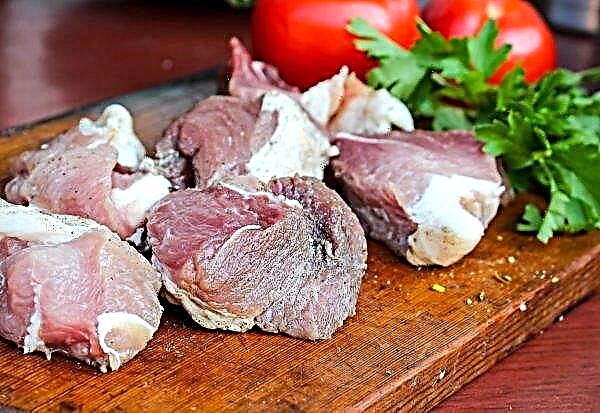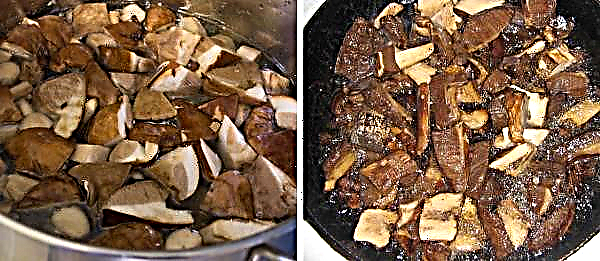Among the variety of tomato varieties, those that can grow in open ground in the northern regions are especially popular. The Moskvich, received by Soviet breeders back in 1976, refers to just such. Read about the features of cultivation and the advantages of the variety in this review.
Grade description
Tomato "Moskvich" is able to grow in the northern regions, including the Arkhangelsk region, Komi and Karelia. It is specially designed for those who are fond of vegetable growing, living in the zone of risky farming. This variety not only tolerates weather conditions well, but also gives a good harvest. Another unique feature of this tomato is that it can be grown even in an apartment due to its low height (40 cm).
The main characteristics of the Moskvich variety:
- a determinant variety with a height of not more than 0.45 m, suitable for growing even on a balcony or window sill;
- type - universal;
- early ripening variety with ripening of the first fruits on the 90-110th day;
- it is intended for cultivation in the open ground in the sprouting way;
- forms a standard, compact, mid-leaf bush, so it can be not tied up and not stepsoned;
- the root system lies close to the surface;
- the trunk is thick, stable;
- corrugated leaves, dark green;
- 3-4 brushes of 5-6 fruits are formed on 1 stalk;
- the yield of 1 bush is about 1 kg;
- productivity - 6–7 kg per 1 sq. m of area;
- fruits - round, smooth, with a dense skin of bright red color;
- fetal weight - 60–80 g;
- taste is sweetish;
- pulp - juicy, fleshy;
- the variety tolerates adverse weather conditions, easily adapts to the soil;
- fruits are resistant to cracking;
- not susceptible to solanaceous diseases: fusarium, rot, late blight, alternariosis, verticillin wilt.
Photo gallery
It is recommended to grow "Moskvich" seedling method. Ripening time is July. Stamp varieties can not be tied, but if there are a lot of fruits, they will be close to the ground and can become infected with rot. Also, tomato can not be stepson, but it pushes the ripening period from 90 to 110 days.Did you know? More than 10 thousand varieties of tomatoes grow in the world: from a tiny “berry” with a diameter of about 5 mm to fruits weighing more than 1.5 kg.
Advantages and disadvantages
- Among the main advantages of the Moskvich variety are the following:
- low strong trunk, which does not need reinforced garter;
- a root system adapted to absorb nutrients from the topsoil, which is convenient for the northern territories;
- increased number of bushes per 1 square. m territory - up to 7–8 pcs .;
- can be grown not only in the garden, but even in the apartment;
- corrugated leaves are characterized by improved ability to photosynthesis, so the tomato does not need a large amount of additional nutrients;
- the variety is resistant to low temperatures, pests and diseases;
- well accepted in the ground;
- seedlings do not stretch;
- precocious;
- strong fruits can be stored in a ripped form for more than 1 month.
- The disadvantages or rather the features of the northern varieties include:
- not very high productivity - up to 1 kg per bush;
- if many fruits are formed, the bush tries to spread along the ground.
Self-growing seedlings
To grow seedlings you will need to prepare:
- seeds;
- soil mixture;
- containers for growing.
Did you know? One of the scientific names for tomato is “Solanum lycopersicum”, which means “wolf peach”. The name is due to the fact that the leaves and trunk of most nightshade are toxic.
The optimum temperature in the room should be 18–20 ° С, humidity - 60–70%. The soil mix can be purchased at the store or stock up on land from the garden. Any type of soil must first be decontaminated. The soil from the site should also be fed with fertilizers, but the soil mix from the store does not need this. Also note that tomatoes are not suitable for indoor flowers - its nutritional properties are aimed at increasing green mass. The soil for vegetables must have a different mineral composition. Seeds before planting will need to be treated for diseases and pests. Accelerate biological processes in them using growth stimulants.
Seeds before planting will need to be treated for diseases and pests. Accelerate biological processes in them using growth stimulants.
Optimum timing for sowing
Variety "Moskvich" is early ripe. The time from the appearance of the first seedlings to the first harvest is 90-100 days. If the bushes are grown without pinching, then the ripening period of the crop is increased by 2 weeks.
You can plant seeds for seedlings in the third decade of March or the first decade of April. The age of seedlings at the time of planting in the soil should be 50–55 days.
The soil
Tomatoes prefer loamy and sandy loamy soils, but grow in any soil except clay. If the soil on your site is clay, then you can improve its structure with the help of sand, sawdust, peat and other additives. Their task is to reduce the density of the soil, improving its aeration and oxygen access to the roots. In addition, the looser the ground, the better the roots develop. It is also important that the soil is always slightly moist, but does not accumulate water after rain. Tomatoes grow best in neutral or almost neutral soil. To understand what level of soil acidity in your area, measure it. A very simple way is to mix a spoonful of soil and a spoonful of vinegar to a creamy consistency. If the mixture foams, then this is an alkaline reaction that is suitable for tomatoes. And if not, the soil is deoxidized with chalk or dolomite flour. For the same purpose, fertilizers containing ammonium sulfate are used.
Tomatoes grow best in neutral or almost neutral soil. To understand what level of soil acidity in your area, measure it. A very simple way is to mix a spoonful of soil and a spoonful of vinegar to a creamy consistency. If the mixture foams, then this is an alkaline reaction that is suitable for tomatoes. And if not, the soil is deoxidized with chalk or dolomite flour. For the same purpose, fertilizers containing ammonium sulfate are used.
Important! The type of root system of tomatoes depends on the method of cultivation. In seedlings, one strong central root and many filiform lateral roots are obtained from the seeds.
Tomatoes grow well in moderately fertile soil with lots of organic matter. To increase fertility, compost is added 1-2 weeks before transplanting seedlings or fertilizers containing potassium and phosphorus. Avoid fertilizers with nitrogen - they increase the leaf mass of the bush, thereby reducing yield.
Most pests winter in the ground. To protect the future crop, soil disinfection is carried out. You can treat the soil with boiling water, as well as with a 3% solution of potassium permanganate (potassium permanganate) both when sowing seeds and before transplanting seedlings to a permanent place.
Video: Preparing the soil for seedlings
Capacity for growing
In the northern regions, growing tomatoes in the open field is only possible in seedlings. For growing seedlings you will need containers. It can be:
- plastic or wooden boxes;
- packaging from yogurts and other dairy products;
- special containers from the flower shop;
- cups of peat;
- peat tablets.
Seed preparation
Moskvich is a variety, not a hybrid, so seeds can always be harvested in the previous year. Germination requires healthy yellow seeds. They are disinfected from possible fungal diseases with warm water (55-60 ° C) for 15-20 minutes, as well as antifungal agents. The most common way is to treat the seeds with a solution of potassium permanganate 3%. In addition, you can purchase various effective synthetic products in the store: Fitosporin, Bactofit, etc. If the seeds have been lying for more than a year or you are not sure about the quality of the purchased seeds, treat them with a growth stimulator. It provides friendly germination, increases germination, increases resistance to diseases, enhances growth. Preparations can be specialized and universal, that is, having all the qualities at once. The most commonly used are Ecogel, Zircon, Novosil. Stimulants are used in strict accordance with the instructions for the drug.
If the seeds have been lying for more than a year or you are not sure about the quality of the purchased seeds, treat them with a growth stimulator. It provides friendly germination, increases germination, increases resistance to diseases, enhances growth. Preparations can be specialized and universal, that is, having all the qualities at once. The most commonly used are Ecogel, Zircon, Novosil. Stimulants are used in strict accordance with the instructions for the drug.
Important! Store seeds at room temperature (14–18 ° C). Seasonal storage at low temperatures reduces the percentage of seed germination by 2 times.
Sowing seeds
Rinse the containers for planting seedlings with detergent. If you used them to grow seedlings in the previous season, then they also need to be sanitized. Fill the containers with 2/3 soil mixture, moisten the soil. The soil should not be wet, otherwise the seeds may rot. If cups are used for sowing, then several seeds are placed in each of them (1–2). If one of them does not germinate, then there will be a seedling from the second in stock. Press the seeds with your finger and apply a thin layer of soil on top. When using boxes, a tape landing scheme is used. The distance between the seeds should be at least 2-3 cm.
If cups are used for sowing, then several seeds are placed in each of them (1–2). If one of them does not germinate, then there will be a seedling from the second in stock. Press the seeds with your finger and apply a thin layer of soil on top. When using boxes, a tape landing scheme is used. The distance between the seeds should be at least 2-3 cm.
Tighten the containers with plastic wrap to speed up the germination process. The greenhouse effect will warm the soil and promote growth even at night. Shoots will appear on the 7-10th day. Once the seeds have sprouted, the film can be removed. To prevent seedlings from stretching, ensure good air circulation and 14-18 hours of daylight using fluorescent lamps.
Did you know? Since 1984, millions of tomato seeds have traveled into space aboard the Challenger Shuttle Mission as part of the NASA project. Then they were grown in schools in Canada and the United States in order to study the influence of space on the growth conditions and taste of tomatoes.
Seedling Care
Seedling care consists of ensuring the right climatic conditions, regular watering, fertilizing, hardening and disease prevention. When 2-3 real leaves appear in seedlings, they must be dived. Dive is required for plants that have been planted in boxes. The method got its name from a thin pointed peg, in French - “piquet”. A peg is introduced into the ground next to the seedling and carefully lifted. This removes the small lower part of the root. The seedling is transplanted into an individual container. Thanks to this procedure, it forms not one core root deep into the soil, but a developed micro-root system, which improves the nutrition of the bush as a whole. Only those seedlings that look healthy and viable should be transplanted.
When 2-3 real leaves appear in seedlings, they must be dived. Dive is required for plants that have been planted in boxes. The method got its name from a thin pointed peg, in French - “piquet”. A peg is introduced into the ground next to the seedling and carefully lifted. This removes the small lower part of the root. The seedling is transplanted into an individual container. Thanks to this procedure, it forms not one core root deep into the soil, but a developed micro-root system, which improves the nutrition of the bush as a whole. Only those seedlings that look healthy and viable should be transplanted.
At the same time, you need to carry out the first feeding of seedlings. This will give the plants additional nutrients necessary for acclimatization to new conditions. It is most convenient to feed seedlings after diving with complex fertilizer. The drug "Agricola" consists of 15% nitrogen, 25% potassium and 21% phosphorus. These are 3 essential trace elements needed by tomatoes. Use the drug according to the instructions. You can use another tool that will contain the same trace elements, or organic fertilizers - mullein or bird droppings. For feeding, bird droppings are diluted with water in a ratio of 1:12, and mullein - 1: 7. The second top dressing is carried out 2 weeks after the first to enhance the development of seedlings. You need to feed the seedlings with the same drug that was used first. Before applying fertilizer to the ground, you should water it, because it is easier for the plant to get food from moist soil.
The second top dressing is carried out 2 weeks after the first to enhance the development of seedlings. You need to feed the seedlings with the same drug that was used first. Before applying fertilizer to the ground, you should water it, because it is easier for the plant to get food from moist soil.
The air temperature in the room must be kept at 18–20 ° С, and humidity - 60–65%. Seedlings tend to reach for a light source, thereby disproportionately lengthening the trunk. To avoid this, use fluorescent lamps over seedlings, they will help create uniform lighting. The daylight hours for seedlings should be at least 14 hours.
Seedling hardening
The conditions in which seedlings grow indoors are different from the harsher outdoor climate. Therefore, 2 weeks before planting in the soil, seedlings begin to harden. The difference in temperature, humidity or the moment of transplantation into the soil - all these are stressful factors for tomatoes. Hardening is designed to reduce the degree of influence of these factors on plants and prepare them for changing climatic conditions.
Did you know? If you spend daily on the tops of tomatoes with your hand, this activates their growth hormone - ethylene, which accelerates the growth and development of the plant.
Tanks with tomatoes are taken out daily to fresh air for 1-2 hours in the daytime in the absence of rain and temperatures above 15 ° C. The hardening time is increased daily by 10–20 minutes.
Planting seedlings in a permanent place
The optimal area for growing tomatoes should be sunny and not retain moisture. Dig the soil. If necessary, apply fertilizer to make its composition more nutritious. And do not forget to disinfect wintering pests. Before planting in the soil, tomatoes must be watered. Dig a hole under each bush. Its size should be larger than the volume of the root system of the transplanted tomato. This is necessary in order to weaken the density of the soil around and to promote the growth of roots. Water the hole, plant a bush and press the ground around the roots. If the plant is extended, dig a part of the trunk into the ground - this will reduce the growth of the stem and create conditions for the formation of a stronger root system. Cover the soil around the bush with mulch. In the early days, the plant needs protection from the sun and wind.
Dig a hole under each bush. Its size should be larger than the volume of the root system of the transplanted tomato. This is necessary in order to weaken the density of the soil around and to promote the growth of roots. Water the hole, plant a bush and press the ground around the roots. If the plant is extended, dig a part of the trunk into the ground - this will reduce the growth of the stem and create conditions for the formation of a stronger root system. Cover the soil around the bush with mulch. In the early days, the plant needs protection from the sun and wind.
Seedlings need to be planted on the 50–55th day. For 1 square. m. you can plant about 7 standard bushes of tomatoes. The distance between the individual bushes is 0.3-0.4 m.
A healthy bush has the following symptoms:
- height - about 25-30 cm;
- tomato should form 8 true leaves;
- the root system is well developed;
- the stem is thick.
 If you want to get an early harvest, plant the tomatoes under the film in a mini-greenhouse.
If you want to get an early harvest, plant the tomatoes under the film in a mini-greenhouse.Features of outdoor care
Caring for tomatoes in the open field includes the same activities that were carried out for seedlings:
- weekly watering;
- fertilizer application;
- plant care;
- prevention of diseases and pests.
Watering
The art of watering tomatoes is very easy to master. Basic techniques:
- make sure that the spray does not fall on the leaves - this contributes to the bacterial infection of tomatoes;
- water should pour very slowly around the bush, saturating the root section;
- do not pour water in such a way that liquid mud champs under your feet — you will simply wash nutrients deep into the soil, from where the roots of the plant cannot extract them;
- moisture should saturate the soil no deeper than 12 cm;
- do not direct the stream towards the stem, do not destroy the micro roots;
- do not water the plants at night - humidity and low temperatures increase the likelihood of diseases;
- use mulch as a moisture regulator on your beds.
It would be nice if, instead of the usual watering for tomatoes, drip irrigation was used. When drip irrigation, water is supplied to the root zone with a dropper dispenser. This allows you to save water and provide the most comfortable watering for plants. A unique feature of such a system is that fertilizers can be applied to the soil in a similar way - for this it is enough to pour them into the tank filling the system. An additional plus: after irrigation, the soil does not stray in a continuous lump and oxygen is well supplied to the roots. Watering is carried out as the soil dries, but not less than 1 time per week.
Watering is carried out as the soil dries, but not less than 1 time per week.
Top dressing
Tomato "Moskvich" can grow on nutrient-poor soils. Therefore, if you forget to make fertilizers, then the variety will tolerate it. Soil acidity should be between 6.0 and 6.5 pH. If tomatoes grow poorly and weeds are good, then this is acidic soil.To deoxidize it, make limestone, dolomite flour, chalk. This lowers the level of acidity from 7.5–7.0 to an acceptable level. Such events should be carried out before planting tomatoes in the ground. If necessary, you can bring limestone directly into the root zone and accompany it with watering.
Granular fertilizers are agents with the gradual release of active substances. Add such fertilizer under the root 1 time, and you have enough for 2 months - this will replace as many as 4 top dressings with liquid solutions. In terms of nitrogen, phosphorus and potassium fertilizers can be balanced, with equal proportions of each fertilizer. An excess of trace elements also negatively affects tomatoes, as well as their lack. Therefore, if you are sure that some substances are not enough - just apply half the dose indicated on the package to the soil. If the tomatoes have correctly formed the ovaries and fertilized, then the further application of fertilizers is already impractical. The total number of standard top dressings is 3. This is fertilizer application:
If the tomatoes have correctly formed the ovaries and fertilized, then the further application of fertilizers is already impractical. The total number of standard top dressings is 3. This is fertilizer application:
- 10 days after planting in the ground;
- in the budding phase (approximately 10-15 days after the previous one);
- in the phase of active flowering and fruit formation (2 weeks after the previous one).
Important! Tomatoes need to be fed with 3 basic fertilizers: nitrogen, phosphorus and potassium. Nitrogen is essential for leaf development, phosphorus - for the development of flowers, and potassium - to enhance plant health.
Stitching and tying bushes
Variety "Moskvich" does not need pinching. But gardeners note that if you do not remove the lateral shoots, then the ripening of the first fruits occurs 1-2 weeks later. Pasynkovka consists in removing side shoots at a height of 0.5 cm.
The variety also does not need to be tied. However, with a large mass of fruits, it begins to slope to the ground, which increases the risk of infection with late blight and other diseases. To maintain a vertical shape, the bush is tied to a peg. It serves as a support for weight maintenance, and also helps to improve air circulation around plants. Tying can be done twice at a height of 20–22 and 30–35 cm. Material for a garter - ribbons from soft fabric. They do not injure the trunk and perform their tasks well. The stores also sell special clips made of soft plastic for tying bushes. These clips can be used for both horizontal and vertical support of the trunk and branches.
Material for a garter - ribbons from soft fabric. They do not injure the trunk and perform their tasks well. The stores also sell special clips made of soft plastic for tying bushes. These clips can be used for both horizontal and vertical support of the trunk and branches.
Soil care
The main types of soil work include:
- weeding weeds;
- aeration (loosening);
- mulching;
- hilling.
 Mulching is another way to control weeds. Mulch is an organic or synthetic material laid on the ground to improve soil conditions and ensure plant health. Wood chips, leaves, grass trimmings, wood chips and compost are organic varieties of mulch. Spunbond, agrofibre and other materials belong to synthetic varieties.
Mulching is another way to control weeds. Mulch is an organic or synthetic material laid on the ground to improve soil conditions and ensure plant health. Wood chips, leaves, grass trimmings, wood chips and compost are organic varieties of mulch. Spunbond, agrofibre and other materials belong to synthetic varieties.- Benefits of mulching:
- prevents soil compaction and erosion;
- inhibits weed growth;
- captures and retains moisture in the soil;
- protects roots from heat;
- protects roots from soil frost;
- protects plants from pests;
- improves soil nutrition.
Mulch is recommended to cover the entire space between the bushes. To prevent weed growth, the mulch layer should be at least 7 cm.
Did you know? The yield is affected by the light that the tomato receives from the sun, as well as reflected from the surface. Reddish mulch reflects wavelengths that increase yield by 15–20 %.
Hilling refers to activities that have both supporters and opponents. Hilling is called the formation of a kind of mound from the soil around the plant. This warms the root zone and promotes root growth. A well-developed root system is able to get more nutrients from the soil, and therefore form a stronger plant with a good harvest. Opponents of hilling believe that the process is suitable for potatoes, as it increases productivity. The first hilling is carried out 2 weeks after the planting of tomatoes in the ground, the second - during flowering.
Opponents of hilling believe that the process is suitable for potatoes, as it increases productivity. The first hilling is carried out 2 weeks after the planting of tomatoes in the ground, the second - during flowering.
Harvesting
The ripening of the first tomatoes occurs on the 90th day after the emergence of seedlings. The fruits ripen gradually throughout July. Harvest from one bush is about 1 kg of tomatoes. With a plantation of 1 square. m collect about 7 kg, depending on how many plants are planted there.
When assembled, the fruits of Moskvich can lie and not deteriorate for up to 1 month. If you intend to store fruits, then remove the stalks during the harvesting process. Place the crop in boxes and store in a dry, ventilated room at temperatures above 5–10 ° C.
Caring for Moskvich tomatoes is extremely simple. This plant can not only grow in the extreme north, but also independently provide itself with nutrients. Caring for these tomatoes is quite possible even for beginners.


